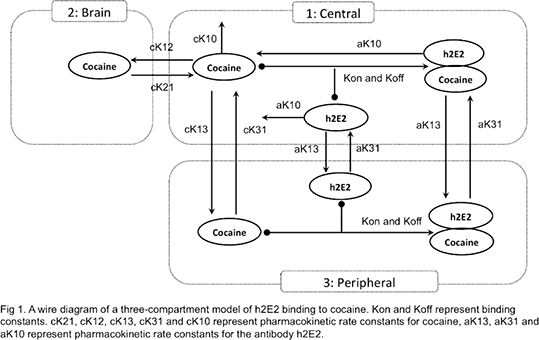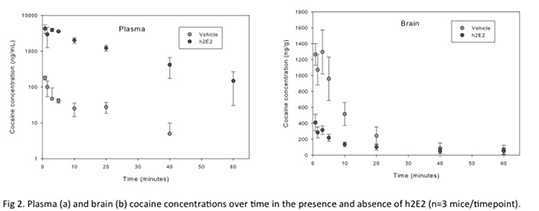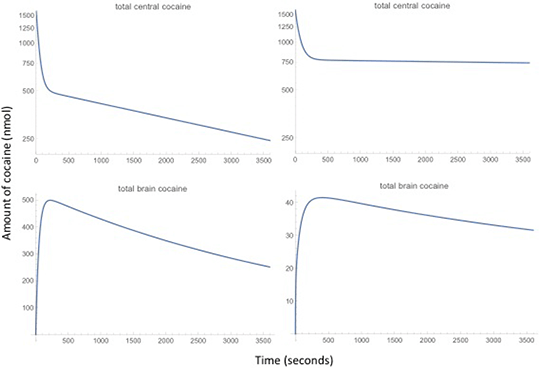| 209P London, UK Pharmacology 2016 |
A mathematical model of a humanized anti-cocaine monoclonal antibody’s effects on cocaine distribution to the brain in mice
Introduction:A recombinant humanized anti-cocaine monoclonal antibody (mAb), h2E2, is at an advanced stage of pre-clinical development as an immunotherapy for cocaine abuse. It is hypothesized that h2E2 binds to cocaine and the antibody/cocaine complex is too large to cross the blood brain barrier. Consistent with this hypothesis, h2E2 has been shown to prevent cocaine’s entry into the brain by sequestering it in the blood in rats [1]. In the current study, mice were used to see whether this effect is conserved across species.
Methods: Mice were injected with h2E2 (120 mg/kg i.v). One hour later, an equimolar dose of cocaine HCl (0.56 mg/kg i.v) was injected. At 8 time points ranging from 45 seconds to 1 hour, mice (n=3/time point) were anesthetized and plasma and brain were collected. Cocaine concentrations were quantified using gas chromatography/mass spectrometry. A three compartment model of the effects of h2E2 on cocaine’s distribution was constructed. The model assumes that h2E2 binds to cocaine and the h2E2/cocaine complex does not enter the brain but is able to distribute between the central and the peripheral compartments. Cocaine and h2E2 were both eliminated from the central compartment only. A diagrammatic version of this model is shown in figure 1. Simulations were executed in Mathematica.
Results:Mean peak plasma concentrations ±SEM in controls were significantly increased (p=0.003) 179.7±21.6 ng/mL, compared to 4250.4±1131.6 in h2E2 treated mice (Fig. 2a). Plasma concentrations in both groups declined over the 1-hour sampling period. However, peak brain concentrations were significantly lower (p=0.01) in the presence of the antibody (1297.5±274.9 ng/mg in vehicle treated mice compared to 409.5±104.2 in h2E2 treated mice) (Fig. 2b). With a set of parameters within the reasonable physiological ranges, the three-compartment model was able to capture the increased plasma concentration in the presence of the antibody, a decline in plasma concentrations over time in both groups (Fig. 3a/b), as well as the decreased peak brain concentration in the presence of antibody (Fig 3b/c).
Conclusions:The mAb h2E2 is able to prevent cocaine’s entry into the brain in mice. A three compartment mathematical model is able to accurately simulate this behavior, indicating that the mechanism proposed in this model may be a plausible representation of the biological system. In the future, this model can be used to explore the effects of mAb affinity and mAb:cocaine stoichiometry on potential clinical effectiveness.
Refrences
1. Norman, A.B., et al., DMD, 2014. 42(7): p. 1125-1131.




